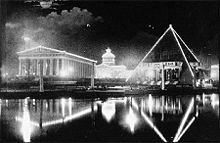
Extravagant displays of electric lights quickly became a feature of public events, as in this picture from the 1897 Tennessee Centennial Exposition.
In 1887 there were 121 Edison power stations in the United States delivering DC electricity to customers. When the limitations of DC were discussed by the public, Edison launched a propaganda campaign to convince people that AC was far too dangerous to use. The problem with DC was that the power plants could economically deliver DC electricity only to customers within about one and a half miles (about 2.4 km) from the generating station, so that it was suitable only for central business districts. When George Westinghouse suggested using high-voltage AC instead, as it could carry electricity hundreds of miles with marginal loss of power, Edison waged a "War of Currents" to prevent AC from being adopted.
Despite Edison's contempt for capital punishment, the war against AC led him to become involved in the development and promotion of the electric chair (using AC) as an attempt to portray AC to have greater lethal potential than DC. Edison went on to carry out a brief but intense campaign to ban the use of AC or to limit the allowable voltage for safety purposes. As part of this campaign, Edison's employees publicly electrocuted animals to demonstrate the dangers of AC;[38][39] alternating electric currents are slightly more dangerous in that frequencies near 60 Hz have a markedly greater potential for inducing fatal "cardiac fibrillation" than do direct currents.[40] On one of the more notable occasions, in 1903, Edison's workers electrocuted Topsy the elephant at Luna Park, near Coney Island, after she had killed several men and her owners wanted her put to death.[41] His company filmed the electrocution.
AC replaced DC in most instances of generation and power distribution, enormously extending the range and improving the efficiency of power distribution. Though widespread use of DC ultimately lost favor for distribution, it exists today primarily in long-distance high-voltage direct current (HVDC) transmission systems. Low voltage DC distribution continued to be used in high-density downtown areas for many years but was eventually replaced by AC low-voltage network distribution in many of them. DC had the advantage that large battery banks could maintain continuous power through brief interruptions of the electric supply from generators and the transmission system. Utilities such as Commonwealth Edison in Chicago had rotary converters or motor-generator sets, which could change DC to AC and AC to various frequencies in the early to mid-20th century. Utilities supplied rectifiers to convert the low voltage AC to DC for such DC loads as elevators, fans and pumps. There were still 1,600 DC customers in downtown New York City as of 2005, and service was finally discontinued only on November 14, 2007.[42] Most subway systems still are powered by direct current.
0 comments:
Post a Comment